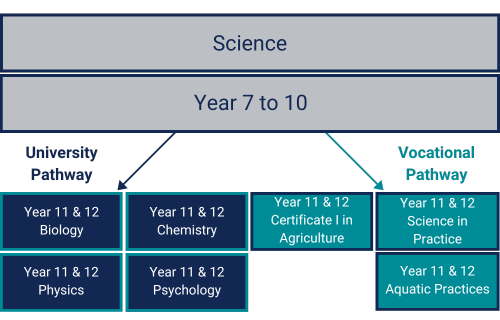Prerequisites
Minimum Level of Achievement required:
- General Science B result
- English C result
- General Mathematics B result
Corequisites
General English
Subject Description
Chemistry is the study of materials and their properties and structure. In Unit 1, students study atomic theory, chemical bonding, and the structure and properties of elements and compounds. In Unit 2, students explore intermolecular forces, gases, aqueous solutions, acidity and rates of reaction. In Unit 3, students study equilibrium processes and redox reactions. In Unit 4, students explore organic chemistry, synthesis and design to examine the characteristic chemical properties and chemical reactions displayed by different classes of organic compounds.
Weekly workload in hours
4+ hours
Structure
Chemical fundamentals - structure, properties and reactions
| Molecular interactions and reactions
| Equilibrium, acids and redox reactions
| Structure, synthesis and design
|
Topic 1
Properties and structure of atoms.
|
Topic 1
Intermolecular forces and gases |
Topic 1
Chemical equilibrium systems
|
Topic 1
Properties and structure of organic materials
|
Topic 2
Properties and structure of materials |
Topic 2
Aqueous solutions and acidity
|
Topic 2
Oxidation and reduction
|
Topic 2
Chemical synthesis and design
|
Topic 3
Chemical reactions -reactants, products and energy change | Topic 3
Rates of chemical reactions
|
| |
Assessment
Schools devise assessments in Units 1 and 2 to suit their local context. In Units 3 and 4 students complete four summative assessments. The results from each of the assessments are added together to provide a subject score out of 100. Students will also receive an overall subject result (A–E).
Summative assessment
Formative internal assessment 1 (FA1): Data test
| 10% | Formative internal assessment 3 (FA3): Student experiment | 20% |
Formative internal assessment 2 (FA2): Research investigation
| 20% |
Formative internal assessment (FA3): 50%
Examination
|
Summative internal assessment 1 (IA1): Data test
| 10% | Summative internal assessment 3 (IA3): Student experiment | 20% |
Summative internal assessment 2 (IA2): Research investigation
| 20% |
Summative external assessment (EA): 50%
Examination |
